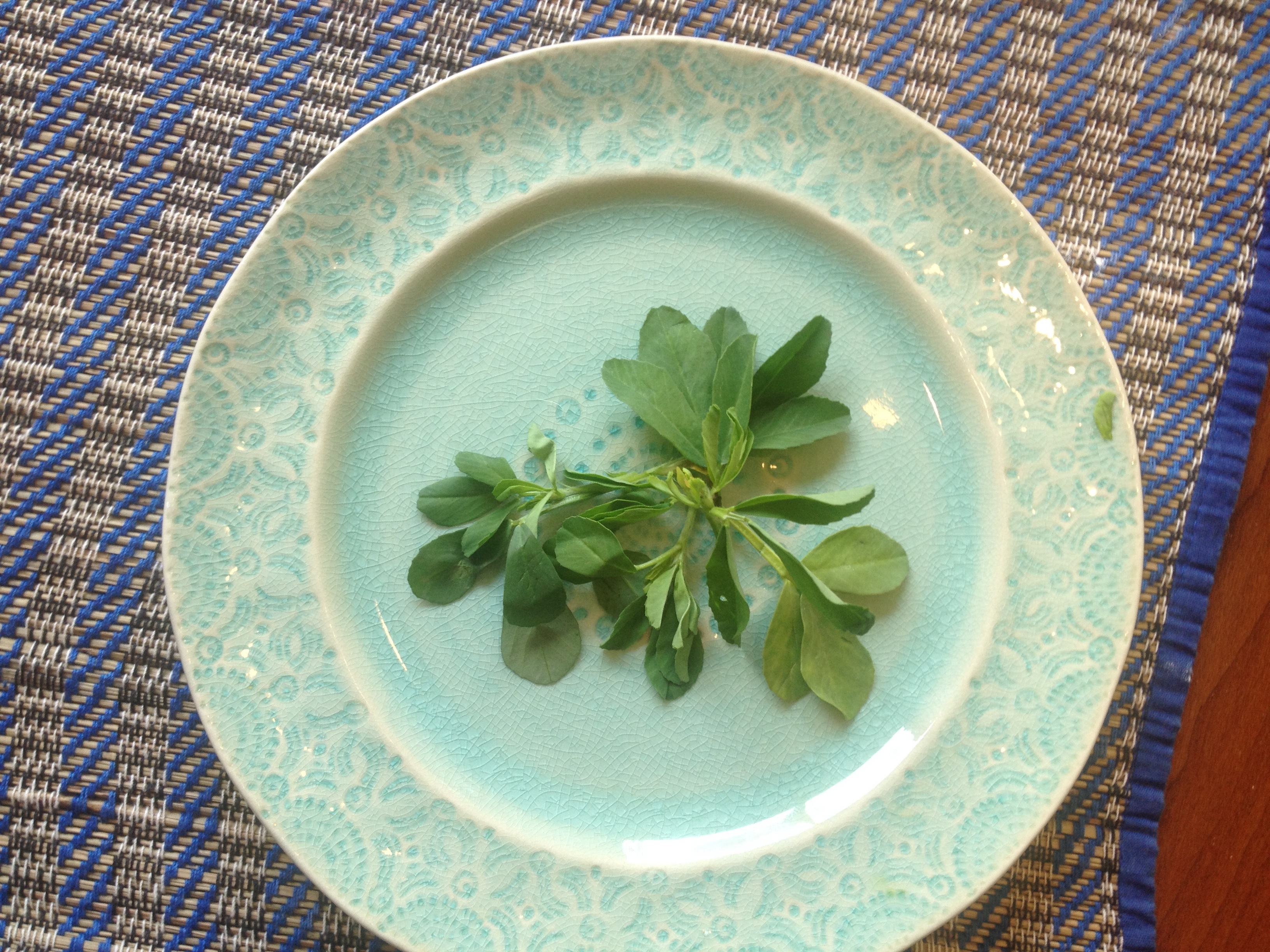We love a good green! Chockfull of health-giving chlorophyll, vitamins, minerals and fiber, they have a permanent spot on our plates and in our hearts (green symbolizes the heart chakra, after all). After spinach, kale, collards, chard, and watercress, you’d think that that our plates and our (green)hearts would be full, but no. Medicinal and delicious, fenugreek leaves (fenugreenery) make an excellent addition to any green repertoire, even if it is already extensive. These leaves, also known as methi in Hindi, helba in Arabic and menthya in Kannada have been rocking traditional Indian and Middle Eastern diets since ancient times. They can rock your world too, starting now.
An Egyptian proverb says, “Fortunate are the feet that tread on the earth on which grows helbeh.” Prized both as a spice and as medicine, Trigonella foenum-graecum, aka fenugreek, is a traditional culinary and medicinal plant. Cultivated in some parts of the world as a semi arid crop, the plant has small round, bright green, slightly bitter but aromatic leaves and is used widely in Indian and Middle Eastern cooking. While fenugreek seeds are also exceptionally therapeutic, they deserve an exclusive spotlight (a piece coming up soon); this write-up is about methi leaves or fenugreenery.
Methi : A Bitter, Better Green
What if you could eat a food that detoxified your liver, helped with digestion, cleansed your body, normalized your blood sugar, reduced oxidative stress and nourished your body with elemental nutrients such as vitamins, minerals and fatty acids?
Manushi, an Indian online journal on nutrition reports,
“The leaves of methi are highly alkaline, and rich in iron, calcium, sulphur, chlorine, and vitamins A and C. They are aromatic and bitter tasting, with as much protein as most pulses, so they make an excellent inexpensive substitute for other sources of protein.”
The journal adds that the rich iron content of methi leaves prevent anemia in adolescent girls, who experience a growth spurt at the onset of puberty. While Western research is lacking on methi leaves, a few animal studies have confirmed their medicinal properties. A study published in 2005 in the Journal of Medicinal Foods reported that the leaves reduced oxidative stress caused by diabetes by acting like an antioxidant. Other studies have casino online found that the leaves, similar to fenugreek seeds (which have numerous studies) have anti-diabetic properties and they also reduced lipids responsible for cardiovascular disease.
A food is so much more than a sum of its parts. Bitter, spirited and bold flavored, methi leaves signify a continual flow of love, insight and nourishment from my ancestors to me. An integral part of my school and family lunches (and suppers), the leaves are like an old buddy of mine, a little bitter, but so very honest! I have always had a soft spot for bitter foods. Dark chocolate, strong coffee, bitter greens, mmm… delicious! Bitter foods, greens especially, have a two-fold action on enhancing digestion, they stimulate both enzyme and bile production.
Elizabeth Schneider, author of Vegetables from Amaranth to Zucchini, says about methi leaves,
“Those who enjoy bitterness for the way it gives backbone to the mild, counter poses sweetness, cleanses the palate, and heightens the sense of taste may wish to know that tender fenugreek leaves also offer hints of celery, fennel, spinach, and split pea. (they are legumes after all).
Methi leaves are easy to incorporate into your dishes. Throw them into smoothies and salads if you want to eat the leaves raw. Else, cook them like any green, or with any other green, with a little fat and salt. They can be added to omelets, grain dishes and stir-fries. Adding complexity and dimension, fenugreenery has the potential to elevate the taste of these dishes and take the body to a higher, and more content spot and park it there. Trust me, they have done it for me for years and I believe that they will do it for you also.
Wishing you many joyful methi moments!
Sources:
Manushi; The Many Uses of Methi
Journal of Medicinal Food; Supplementation of Fenugreek Leaves to Diabetic Rats. Effect on Carbohydrate Metabolic Enzymes in Diabetic Liver and Kidney.
Bitter; A Taste of the World”s Most Dangerous Flavor
Vegetables from Amaranth to Zucchini
How the Banana Goes to Heaven
Mind Body Green; 3 Reasons to Eat Bitter Greens Everyday
